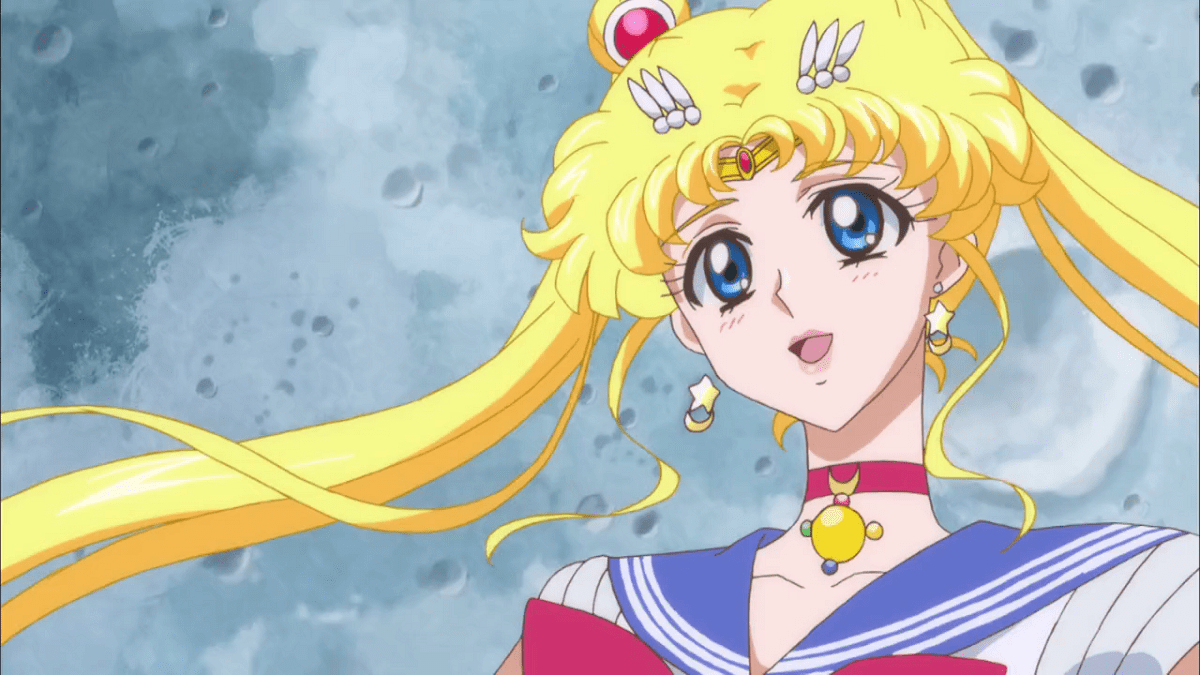The following was originally posted on Dee Hogan’s blog The Josei Next Door and has been republished with permission.
Fall is at an end, but that doesn’t mean its best shows have to be.
We saw two forms of storytelling make a welcome comeback this season: the high fantasy and (perhaps even more importantly) the long-form anime series. As anyone who’s been watching simulcast anime over the past few years will know, one-cour shows have become the norm, and anything longer a happy exception. This season, though, a whopping nine of the 13 shows on my watchlist ran longer than that, and seven of them will be continuing into the coming seasons. So there are a ton of “midseries” reviews in this bunch – and hey, what better time to catch up on some great shows than over the holiday break?
Overall it wasn’t the best of anime seasons, full of shows that fluctuated dramatically in tone and quality (Fate/stay night, Gugure! Kokkuri-san, Your Lie in April), one that shot itself in the foot (Yuki Yuna is a Hero), and a few that suffered to varying degrees from not getting more episodes to tell their extensive stories (Rage of Bahamut, Laughing Under the Clouds). But hey, no season with Mushishi will ever be a total failure, and there were two incredibly consistent, solid, just good old-fashioned well-told stories to round out the Top Three. So let’s focus on those first, starting with one of the great masterpieces of anime, back for its (sniffle) final round of episodes.
RANKINGS
1. Mushi-shi: The Next Passage (Mushishi ZOKU SHOU)
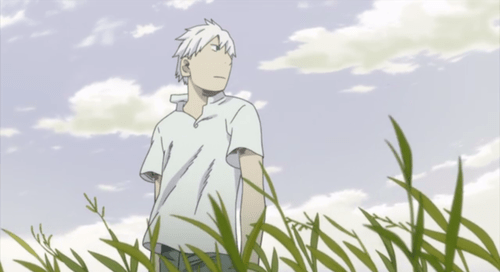
Available on: Crunchyroll (US, Canada, United Kingdom, Ireland, Australia, New Zealand, South America, Europe, Middle East, and Africa) (listed as “MUSHI-SHI”)
Season Episode Count: 20 (21 if you count the mid-season special “Path of Thorns”)
Series Episode Count: 48 (including the OVA)
Note: Crunchyroll does not carry the original 26-episode Mushishi anime. It’s available on Funimation and Hulu (U.S./Canada), and also in a very cheap S.A.V.E DVD boxset.
In a Sentence: A sequence of loosely connected short stories about a world where humans coexist with strange creatures called “mushi,” and the wandering mushi expert (“mushi-shi”) Ginko, who works to keep the two spheres in harmony with one another.
Content Warning: Some of the stories do touch on grimmer subjects such as abuse, mental illness, and violence, but these topics are always explored thoughtfully and never for shock value, so I encourage you to give the show a try regardless.
I said in my Premiere review that at a certain point you run out of adjectives to describe a show and just start throwing confetti at it, and I’ve pretty much reached that point with Mushishi. Few series in any medium explore the full spectrum of human psychology, experiences, and relationships (both between two people and between humanity and nature) quite like this series, using the (super)natural world of mushi to literalize intangible thoughts and emotions. Few series understand the value of silence and empty spaces, of understatement and minimalism, of exploring complex ideas with subtlety and sympathy, presenting but never overtly moralizing. And even fewer series can take an excellent manga and turn it into something even better, blending the original writing and art with quietly expressive vocal performances, lush, ephemeral backgrounds, and a meditative musical score.
Simply put, this is a top-tier show, easily the best anime of the season and one of the greatest anime ever made. If you’re not watching it already, you’re missing out on a lovely, haunting, and utterly unique experience. This is a show meant to be savored rather than gobbled (I’d recommend 1-2 episodes a week as the optimal way to watch it), but it’s well worth every bite.
Series Grade: Technically the “series” isn’t over just yet – Artland’s releasing a film version of the final manga chapters (the two-part “Drops of Bells”) this summer – which is why I haven’t written a full series review. But I think it’s safe to grade the TV anime as a whole, and it’s the easiest grade I’ve ever given: A+
2. Yona of the Dawn (Akatsuki no Yona)
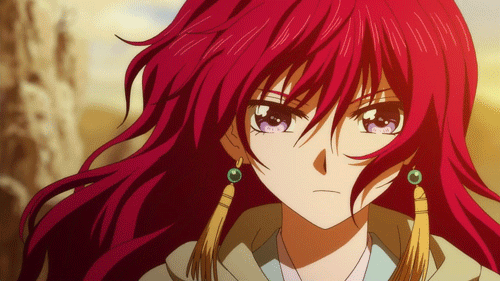 Available on: Crunchyroll (worldwide with the exception of Asia); Funimation (U.S./Canada) (listed as “Yona of the Dawn”)
Available on: Crunchyroll (worldwide with the exception of Asia); Funimation (U.S./Canada) (listed as “Yona of the Dawn”)
Episode Count: 12 (ongoing)
In a Sentence: Yona, pampered princess of the Kouka Kingdom, is forced to flee the palace after a surprise attack disrupts her sixteenth birthday.
Content Warning: Violence (against adults/teens); some implied sexual content.
I wrote this review last, not because I don’t love this show, but because I’m struggling to explain why I love it as much as I do. There’s nothing particularly flashy about it, nothing jaw-dropping in its execution. It’s well-drawn, competently animated, with a musical score that fits the mood and setting without overpowering it. The story takes its time from one point to the next, never dragging its feet but never hurrying, either, allowing its characters and their relationships (both with each other and with their own pasts) to move things forward in a natural, organic way.
And perhaps that in itself is why Yona is so good: it makes great storytelling look like the simplest thing in the world. It never calls attention to its own production, to the animation or writing or music – instead, it simply draws you into its world (an eastern fantasy realm based loosely on medieval Korea), and lets you experience it and all the people and legends that inhabit it. The story is emotional and honest when it wants to be, tense and action-packed when it wants to be, and damn funny when it wants to be, too. Protagonist Yona is a dynamic character but not unnaturally so: she grows gradually with each episode, affected by her experiences, her relationships with her ever-expanding cast of companions, and her own wants and needs. It’s been good since the first episode, and shows no signs of letting up.
Great, consistent character-driven storytelling is by no means an easy task. Yona, though? Yona makes it look effortless.
Midseries Grade: A-
3. Parasyte -the maxim- (Kiseijuu: Sei no Kakuritsu)
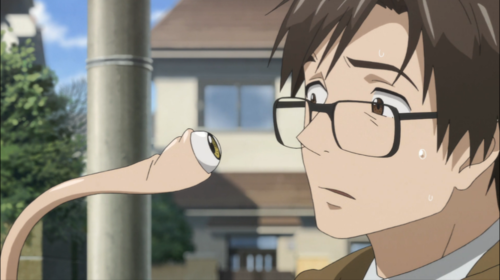
Available on: Crunchyroll (USA, Canada, South Africa, Australia, New Zealand, Latin America [Central and South America], Europe, Middle East, and North Africa)
Episode Count: 12 (ongoing)
In a Sentence: High school senior Izumi Shinichi finds himself host to a sentient but merciless parasite as a number of snake-like creatures appear in Japan and begin infecting the populace.
Content Warning: Graphic violence (against teens/adults); some nudity/sexual content (male and female).
I gave the #2 slot to Yona instead of this one mostly for subjective reasons, because in terms of overall quality (storytelling, character development, production values, etc.) they’re neck-and-neck, and your reactions here will probably have more to do with genre preferences than anything. Parasyte began as an unsettling “secret invasion” style horror story and has since morphed into an action-sprinkled character study, equal parts philosophy and violence. More sci-fi than horror, the series uses its supernatural elements to explore not just the difference between “human” and “monster,” but also the difference between children and adults, and all the frustrations and fears of adolescence.
It’s a unique coming-of-age story, strange in its events but familiar in its characters, as our teen protagonists are driven by a muddled blend of affection/attraction for one another, naivety about the threats around them, and a desperate hope that things aren’t as bad as they seem, which can sometimes make them react with a brash foolishness that’s dangerous at best and downright deadly at worst. There’s realism and metaphor here that makes Parasyte much more than just a creepy gore-fest, and while it (like Yona) is never flashy, it’s rock solid and confident and grows more compelling each week. I’m excited to see where the second half takes us.
Midseries Grade: A-
4. YowaPeda (Yowamushi Pedal: Grande Road)
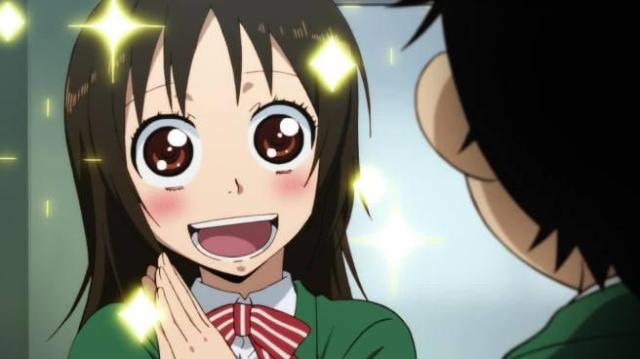
Available on: Crunchyroll (United States, Canada, Caribbean, South Africa, and Central and South America) (listed as “Yowapeda”)
Season Episode Count: 12 (ongoing)
Sequel to: Yowamushi Pedal (38 episodes)
In a Sentence: High school freshman (and total otaku) Sakamichi Onoda finds himself drawn into the world of road racing when his climbing skills catch the eye of the school’s competitive cycling team.
Content Warning: Soooo many sweaty shirtless dudes (mild male fanservice, basically).
YowaPeda continues to combine earnest sports bromances, goofball humor, over-the-top melodrama (mostly of the intentionally silly variety), and moments of genuine heart and hardship as the Interhigh competitors pedal furiously towards the finish line. The series has never been afraid of slowing down the pacing, alternating between the actual race and personal flashbacks to flesh out the various competitors, but it’s led to some repeated character beats as of late which has dulled the tension rather than enhanced it.
Even so, YowaPeda is still YowaPeda: Silly and serious in equal turns, with an infectiously likable cast and a protagonist with a heart as big as his glasses. Even when it isn’t firing on all cylinders, YowaPeda is still a fine series, worthy of the top ranks of any season.
Midseason Grade: B+
5. Rage of Bahamut: Genesis (Shingeki no Bahamut: Genesis)
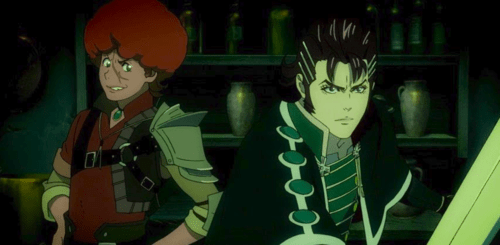
Available on: Funimation (U.S./Canada)
Episode Count: 12
In a Sentence: Bounty hunter Favaro finds himself dragged into a battle of apocalyptic proportions when a demonic stranger requests his aid in reaching a place called Helheim.
Content Warning: Violence (against adults… okay, and zombie children); mild nudity/fanservice (both male and female).
Rage of Bahamut has a classic Hollywood feel to it, epic and bombastic and generally just a whole lot of fun. The central characters are a charming bunch of misfits, easy to root for and entertaining in their interactions, and while the CG animation is often out-of-place and clunky (sometimes distractingly so), the 2D work is uniquely stylized in its art and dynamic in its execution, bringing the big action scenes to life with panache.
That said, the second half of this all-too-short series is a deluge of plot points, twists, and full-steam-ahead pacing, which left many of the side characters underdeveloped, forced a somewhat awkward InfoDump at one point, and made the big reveals seem haphazard, even though the story actually did fit together and make sense (more or less). A series this epic in scope – with so many places and stories and characters to explore – could have easily stretched to two cour, and it’s a shame (albeit an understandable one, given the production values) that studio MAPPA didn’t take a financial risk on it and give it the extra episodes it deserved.
Shortcomings aside, I liked this one quite a lot, and would recommend it to anyone who enjoys an old-school western high fantasy, even if you’re not all that into anime. I also have the feeling it would make a fantastic binge-watch.
Series Grade: B
6. SHIROBAKO
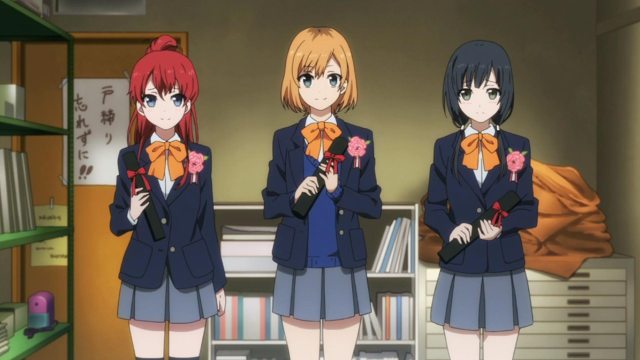 Available on: Crunchyroll (USA, Canada, South Africa, Latin America, United Kingdom, Ireland, New Zealand, The Netherlands, Scandinavia, Turkey, and Australia)
Available on: Crunchyroll (USA, Canada, South Africa, Latin America, United Kingdom, Ireland, New Zealand, The Netherlands, Scandinavia, Turkey, and Australia)
Episode Count: 12 (ongoing)
In a Sentence: Five friends promise each other that they’ll make it in the anime industry – and two years later, their dream comes true in all its stressful, unglamorous glory.
Probably the happiest surprise of the season, SHIROBAKO is a workplace comedy that nicely captures the frantic pace of approaching deadlines, the way coworkers (of varying levels of competence) cycle in and out of each other’s daily lives, and the sense of aimlessness and/or stagnation so common in the early years of being a young professional. The show discusses the difficulties of working in today’s anime industry and pokes fun at some of the (pretty awful) series being made, but it’s a soft touch: the criticism is light, the humor tongue-in-cheek, and the tone mostly conciliatory and optimistic.
As such, SHIROBAKO occasionally veers into the realm of “follow your dreams,” saccharine, cute-girls-being-cute fluff, and it could certainly stand to be a little sharper and more satirical. Even so, it maintains a sense of fun, provides a moderately enlightening (albeit sugar-coated) “behind the scenes” look at the anime biz, and proves itself adept at getting at least one good giggle out of me, particularly when it veers into the realm of surreal, Scrubs-esque fantasy sequences. It’s nothing jaw-dropping, but it’s solidly entertaining each week, and I’m happy to spend another cour with the good folks at Musashino Animation.
Midseries Grade: B
7. Fate/stay night [Unlimited Blade Works]
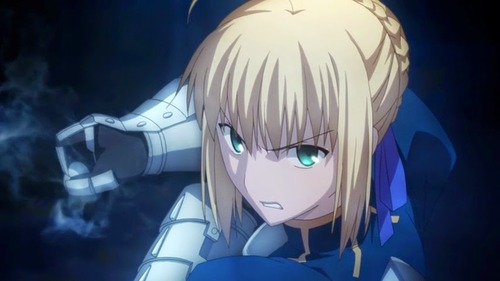
Available on: Crunchyroll (North America, Central America, South America, Australia, New Zealand, United Kingdom, Ireland) (listed as “Fate/stay night”)
Episode Count: 12 (ongoing)
In a Sentence: When a stranger attacks his home, high school student and amateur mage Emiya Shirou accidentally summons a Heroic Spirit to defend him and winds up dragged into the ongoing Holy Grail War.
Content Warning: Violence (against teens/adults); mild fanservice (some male, mostly female).
I loved the prequel series (Fate/Zero) and really wanted to love this remake of the “original” as well. And there are times when I do – when the show focuses on the Grail War; when it pits two Heroic Spirits and their competing blades and ideals against each other; when it lets its characters interact and grow organically within its grand world and story. Fellow blogger Enzo calls these the moments in which the series handles itself with dignity, and I think that’s a pretty spot-on assessment.
But then there are the other moments, most of them taking place at school, and the series simply doesn’t know how to write high schoolers in their natural habitat without pandering to stereotypes and stock “humor” (in quotes because F/sn is more-or-less incapable of actually being funny, despite its lackluster attempts). These “slice of life” moments lack any of the energy of the rest of the series, and it drags the story and the characters down just about every time it happens. The bizarre fluctuation in tone and pacing keeps the series from ever truly achieving greatness, although it flirts with it often enough that it’s definitely got my attention. Part 2 airs in the Spring. We’ll see if things will even out and achieve a tighter focus as we head toward the finale.
Midseries Grade: B
8. Gugure! Kokkuri-san

Available on: Crunchyroll (USA, Canada, UK, Ireland, South Africa, Australia, New Zealand and Latin America)
Episode Count: 12
In a Sentence: While playing the Ouija board-style kokkuri divination game, self-proclaimed “human doll” Ichimatsu Kohina summons the fox spirit Kokkuri-san into her home, which opens the door to a whole mess of spirits entering her life.
Content Warning: Is there an “all of the above” checkbox? It’s a comedy without many boundaries, so there’s violent slapstick and mild fanservice, and the darker humor runs the gamut from murder to pedophilia to sexual harassment (to be fair, most of the humor comes from the other characters condemning such behavior, but it’s still played for laughs), and there are a couple brief scenes that feature some truly awful homophobia and transphobia.
After writing that “content warning” I realized how hard it was going to be to briefly explain why I’m still giving Kokkuri-san a passing grade, but it’s the kind of show where the good stuff – the smarter jokes, the surprising flashes of character depth, and the moments of genuine heart – outweighed the bad stuff (for me, anyway; I completely understand if others hated it).
Rather than being a pointless puff comedy full of cute animals and “edgy” humor, Kokkuri-san actually did try to be about something, exploring topics of loneliness, abuse, social exclusion, grief, and how these affect our personal identities and relationships with others. And the humor landed more often than it didn’t, shifting between pure silliness and sharp commentary that provided a lot of laugh-out-loud moments, even if there were times when I wanted to punch a hole through my TV. It’s definitely not for everyone, but there is something of value here, making it worth a watch if you can get through the more problematic scenes.
I explain this in greater detail in my Series Review, so you can read that for more.
Series Grade: B-
9. Your Lie in April (Shigatsu wa Kimi no Uso)
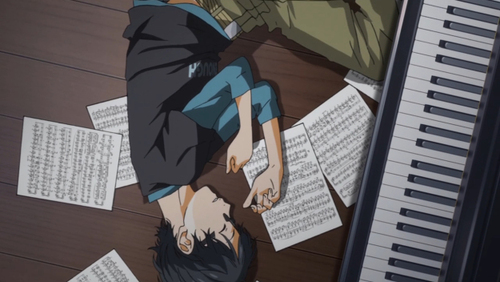
Available on: Crunchyroll (North America, Central America, South America, Australia, New Zealand, United Kingdom, and Ireland)
Episode Count: 11 (ongoing)
In a Sentence: After childhood trauma left 14-year-old pianist Kousei Arima unable to hear his own piano playing, a chance meeting with violinist Miyazono Kaori sends him back into the world of classical music.
Content Warning: Child abuse (both physical and emotional); violent slapstick; gender essentialism out the wazoo (I don’t usually notice it that much, but geez).
As tonally inconsistent as Fate/stay night and as problematic and polarizing as Kokkuri-san, KimiUso hit a major high in its second episode and then proceeded to slowly run itself into the ground for the next three, creating an unpleasant cocktail of tasteless slapstick and “comedic” bullying topped with puzzlingly uneven views on art and artists, trauma, and gender roles. But dammit if the music wasn’t fantastic, the production values high, the main character just sympathetic enough, and the story just promising enough to keep me hanging on (although plenty of other viewers and bloggers fled, understandably so).
The series mercifully evened out and righted itself about halfway through the sixth episode and has been much more sensitive to its protagonist’s condition since. There are still issues, mind you: the dialogue fluctuates between sounding natural and sounding eye-rollingly pretentious; as Fantastic Memes points out, the direction is just not very good; and yikes, is the gender essentialism strong with this one (Kousei can handle these problems because he’s a man, you guys!) And yet, the flickers of a meaningful, emotionally resonant story about working through trauma and abuse are growing stronger each week, which gives me hope for the second half. And hey, if nothing else, the music should continue to be great.
Midseries Grade: C+
10. Chaika -The Coffin Princess- (Hitsugi no Chaika: Avenging Battle)
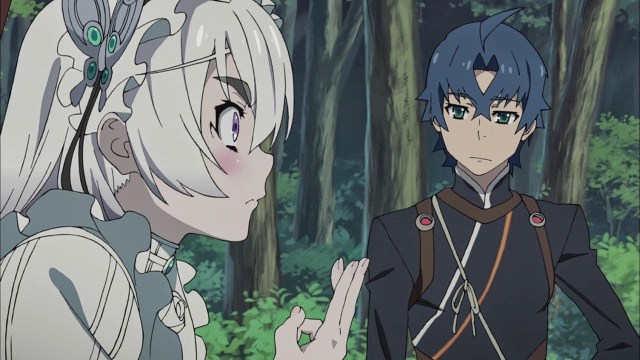
Available on: Crunchyroll (the list of regions is too long to include, so here’s a link) (listed as “Chaika -The Coffin Princess-”)
Season Episode Count: 10
Series Episode Count: 22
In a Sentence: Chaika, daughter to the deposed Emperor Gaz, enlists the help of two former specialized soldiers called “saboteurs” to help her gather the scattered remains of her deceased father.
Content Warning: Violence (against adults/teens); talk of sexual violence; mild fanservice.
There’s not much to say about Chaika. It’s an enjoyable fantasy series with enjoyable characters, smoothly animated action sequences, and a plot that thickens as the series goes. There’s a noticeable lack of growth from the main cast, which takes some of the tension out of the later episodes, and I confess to finding the side characters (particularly the Gillette Squad) more intriguing than the primary ones as the series went on. But the show pulls its ensemble together for a big, explosive finale, and despite some issues with character motivation (particularly among the villains), it finds a satisfying finish, both melancholy and hopeful. It’s not going to win any awards, but it makes for a pleasant diversion all the same.
Series Grade: C+
11. Laughing Under the Clouds (Donten ni Warau)

Available on: Funimation (U.S./Canada) (listed as “Laughing Under the Clouds”)
Episode Count: 12
In a Sentence: In a fantasy reimagining of early Meiji Japan (late 1860s), the three Kumoh brothers struggle to stay alive and together as forces both mundane and supernatural threaten to tear their family and world apart.
Content Warning: Violence (against adults/teens), brief nudity (male and female).
Laughing Under the Clouds (shorthand: “DnW” for the Japanese title) had a lot going for it in terms of overall world and story, and it gets plenty of points for originality. A historical fantasy focusing on fraternal relationships rather than a romance? Massive island prisons, ninja clans, priests and their familiars, and a world-devouring snake called the Orochi who uses a human vessel to resurrect itself every few hundred years? This is the stuff of big battles and unashamed melodrama; of sweeping, sprawling epics, and shocking twists, reveals, and betrayals.
And it could have been – if only it hadn’t fumbled in the execution. Action sequences were stilted, crippled by what I’d guess to be a small budget and a director who didn’t know how to hide those financial limitations, and both Kaji Yuuki (Soramaru) and Yonaga Tsubasa (Chutaro) felt awkwardly miscast, struggling to hit both humorous and dramatic beats. But the series’ biggest issue was its pacing, as it barreled through a huge story and cast in 12 short episodes, sprinting past important character moments and making the many plot twists feel forced rather than organic. DnW is a prime example of why it’s a bad idea to tell an epic in a single cour, and I can’t help but think of what might have been had the series gotten another 10-12 episodes to properly craft its characters and story.
Series Grade: C
12. Yuki Yuna is a Hero (Yuki Yuna wa Yusha de Aru)
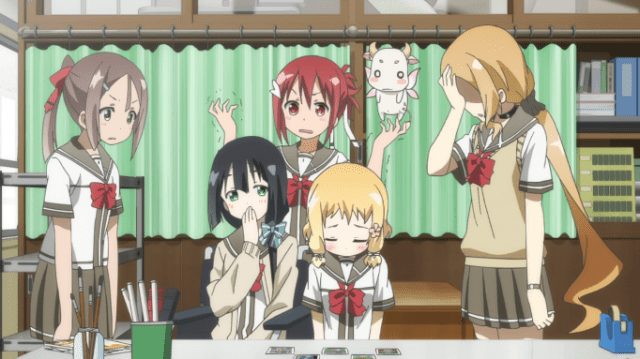 Available on: Crunchyroll (Worldwide except for Asia)
Available on: Crunchyroll (Worldwide except for Asia)
Episode Count: 12
In a Sentence: The members of the junior high “Hero Club” find themselves thrown into a supernatural battle when they’re chosen to protect the divine Shinju-sama.
Content Warning: Violence, trauma (physical and emotional), mild fanservice.
What an unbelievable waste of potential. Yuki Yuna featured a solid writer/director team with a stylistic flair and a willingness to take a cute magical girl show into some dark, compelling directions. The series first set itself up as a fun, energetic friendship story in the Rayearth/Sailor Moon tradition; then it became an exploration of what it means to be a “hero” and of the physical and psychological ramifications of battle; then it cranked the depth up to 11 and seemed as if it was going to be a scathing critique of the moe genre and the quite frankly disgusting trend of making young, “pure” girls suffer just so some faceless audience can fetishize and “worship” them and their sacrifices.
And then… it took the coward’s way out, jumping back to its original topics of friendship and naive heroism, hand-waving away all the earlier problems and assuring us that all suffering can be fixed with a little Friendship and Willpower. (If I said the series My-HiME’d itself, I wonder how many people would know what I meant?) As the credits rolled, I was still trying to salvage something worthwhile from the ending—about the importance of human connections and personal strength in overcoming injuries both physical and spiritual—but I just can’t make it work. In the end, despite shining a light on some of the problems inherent in many anime featuring young girl protagonists, Yuki Yuna succumbed to those same problems, and its self-awareness only made it that much more disappointing.
Series Grade: D
Unranked: Sailor Moon Crystal
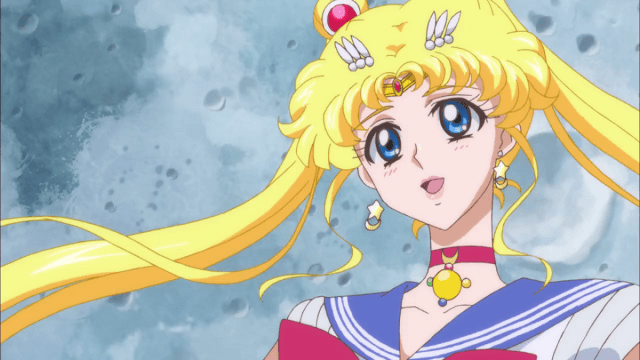
I was going to rank it this time, I really was, but we’re one episode from the mid-season finale and I didn’t want to wait until Saturday to get this darn thing out (I still have a Top 10 of 2014 list to post, y’know), so I figured I’d skip it again. If you’re wondering, my opinion of it is… not great. For a while there I was pegging it as a middle-of-the-road kind of series, bland in its execution and uninspired in its direction, but enjoyable enough, and never outright offensive.
But then Episode 11 happened, a rapid-fire mess of pacing issues that left zero time to process emotional moments (“I remembered who I am!” *CRATERED*), inexplicable melodrama (#StabStabRegret?), and truly awful vocal performances (Metalia’s Evil Noise is literally “Bwehhhh”). Simply put, I found it unintentionally hilarious, so bad it was kind of fantastic, and I can’t decide if that would make me give it a better or worse grade at this point. So maybe it’s for the best that we leave it here for now, and not worry about rankings just yet.
Dee (@JoseiNextDoor) is a writer, a translator, a book worm, and a basketball fan. She has bachelor’s degrees in English and East Asian studies and a master’s degree in Creative Writing. To pay the bills, she works as a technical writer. To not pay the bills, she writes young adult novels, watches far too much anime, and cheers very loudly for the Kansas Jayhawks. You can find her at The Josei Next Door, a friendly neighborhood anime blog for long-time fans and newbies alike.
Are you following The Mary Sue on Twitter, Facebook, Tumblr, Pinterest, & Google +?



